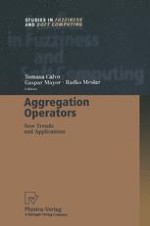1. The increasing number of research papers appeared in the last years that either make use of aggregation functions or contribute to its theoretieal study asses its growing importance in the field of Fuzzy Logie and in others where uncertainty and imprecision play a relevant role. Since these papers are pub lished in many journals, few books and several proceedings of conferences, books on aggregation are partieularly welcome. To my knowledge, "Agrega tion Operators. New Trends and Applications" is the first book aiming at generality , and I take it as a honour to write this Foreword in response to the gentle demand of its editors, Radko Mesiar, Tomasa Calvo and Gaspar Mayor. My pleasure also derives from the fact that twenty years aga I was one of the first Spaniards interested in the study of aggregation functions, and this book includes work by several Spanish authors. The book contains nice and relevant original papers, authored by some of the most outstanding researchers in the field, and since it can serve, as the editors point out in the Preface, as a small handbook on aggregation, the book is very useful for those entering the subject for the first time. The book also contains apart dealing with potential areas of application, so it can be helpful in gaining insight on the future developments.
